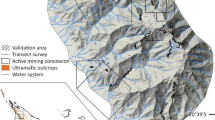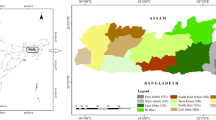Abstract
Species distribution modelling (SDM) has been used to support biodiversity management in recent years. However, the use of SDM at small scales with geolocation systems to obtain high-accuracy location data remains unexplored. In this study, we focused on Euphorbia fontqueriana, an endangered species to Mallorca (western Mediterranean basin), and we aimed to assess the spatial distribution patterns, and to generate a distribution map of the habitat suitability in a wider area. A differential GPS was used to geolocate all the ramets. We used the global Moran’s I index and local Getis Ord-Gi* method to assess the spatial patterns. We pre-selected derived topographic variables that were generated from LiDAR data (elevation, slope, northness and eastness), the connectivity index, normalised difference vegetation index, and soil type, as the environmental (predictor) variables. In addition, we ran the Maxent model using 1603 occurrence locations and seven environmental variables at a resolution of 2 × 2 m in grid size. The population consisted of 1625 ramets that were clustered (global Moran’s I index = 0.161, z score = 16.599, p value < 0.001) in several hotspots (i.e. areas with high plant density that were surrounded by areas with high plant densities). The Maxent model, which showed a good performance (AUC training score = 0.977), generated a habitat suitability map that displayed zones of high suitability in other areas away from the natural geographical area. Finally, we discuss the usefulness of this study to guide management purposes.










Similar content being viewed by others
References
Albert MJ, Iriondo JM (2009) Euphorbia fontqueriana Greuter. In: Iriondo JM, Albert MJ, Giménez Benavides L, Domínguez Lozano F, Escudero A (eds) Poblaciones en peligro: viabilidad demográfica de la flora vascular amenazada de España, Dirección General de Medio Natural y Política Forestal. Ministerio de Medio Ambiente, y Medio Rural y Marino), Madrid, pp 89–92
Anselin L, Syabri I, Kho Y (2006) GeoDa: An Introduction to Spatial Data Analysis. Geogr Anal 38:5–22
Bayly MJ, Angert AL (2019) Niche models do not predict experimental demography but both suggest dispersal limitation across the northern range limit of the scarlet monkeyflower (Erythranthe cardinalis). J Biogeogr 46(7):1316–1328
Booth TH (2018) Species distribution modelling tools and databases to assist managing forests under climate change. For Ecol Manag 430:196–203
Borthakur SK, Sharma Baruah P, Deka K, Das P, Sarma B, Adhikari D, Tanti B (2018) Habitat distribution modelling for improving conservation status of Brucea mollis Wall. ex Kurz.—An endangered potential medicinal plant of Northeast India. J Nat Conserv 43:104–110
Braun-Blanquet J (1979) Fitosociología. Bases para el estudio de las comunidades vegetales. H. Blume Ediciones, Madrid
Cavalli M, Trevisani S, Comiti F, Marchi L (2013) Geomorphometric assessment of spatial sediment connectivity in small Alpine catchments. Geomorphology 188:31–41
Cook RE (1985) Growth and development in clonal plant populations. In: Jackson JBC, Buss LW, Cook RE (eds) Population biology and evolution of clonal organisms. Yale University Press, New Haven, pp 259–296
Draper D, Marques I, Iriondo J (2019) Species Distribution models with field validation, a kew approach for successful selection of receptor sites in conservation translocations. Global Ecol Conserv. https://doi.org/10.1016/j.gecco.2019.e00653
Elith J, Graham C, Anderson R, Dudík M, Ferrier S, Guisan A, Hijmans R, Huettmann F, Leathwick J, Lehmann A, Li J, Lohmann L, Loiselle B, Manion G, Moritz C, Nakamura M, Nakazawa Y, Overton J, Peterson A, Zimmermann N (2006) Novel methods improve prediction of species’ distributions from occurrence data. Ecography 29:129–151
Elith J, Phillips SJ, Hastie T, Dudík M, Chee YE, Yates CJ (2011) A statistical explanation of MaxEnt for ecologists. Divers Distrib 17(1):43–57
Environmental Systems Research Institute (ESRI) (2017) ArcGIS Release 10.6
Far JA (2019) Reproductive biology and habitat characterization of Euphorbia fontqueriana Greuter, an endangered endemism from Mallorca. Master Thesis dissertation, University of the Balearic Islands
Fenu G, Bacchetta G, Christodoulou C, Fournaraki C, Pietro G, Gotsiou P, Kyratzis A, Carole P, Vicens M, Pinna M, Montmollin B (2019) An early evaluation of translocation actions for endangered plant species on Mediterranean islands. Plant Divers 41(2):94–104
Fois M, Fenu G, Cuena Lombraña A, Cogoni D, Bacchetta G (2015) A practical method to speed up the discovery of unknown populations using Species Distribution Models. J Nat Conserv 24(C):42–48
Fox J (1997) Applied regression analysis, linear models, and related methods. SAGE Publications, Thousand Oaks
Getis A, Ord JK (1992) The Analysis of Spatial Association by Use of Distance Statistics. Geogr Anal 24:189–206
Gianinetto M, Aiello M, Vezzoli R, Polinelli F, Rulli MC, Chiarelli D, Bocchiola D, Ravazzani G, Soncini A (2020) Future scenarios of soil erosion in the Alps under climate change and land cover transformations simulated with automatic machine learning. Climate 8:28
Gogol-Prokurat M (2011) Predicting habitat suitability for rare plants at local spatial scales using a species distribution model. Ecol Appl 21(1):33–47
Greuter W (1968) Une espèce méconnue edémique des Illes Baléares: Euphorbia fontqueriana. Coll Bot (Barcelona) 7(1):531–537
Guisan A, Zimmermann NE (2000) Predictive habitat distribution models in ecology. Ecol Model 135(2–3):147–186
Guisan A, Tingley R, Baumgartner JB, Naujokaitis-Lewis I, Sutcliffe PR, Tulloch A, Regan T, Brotons L, McDonald-Madden E, Mantyka-Pringle C, Martin T, Rhodes J, Maggini R, Setterfield S, Elith J, Schwartz M, Wintle B, Broennimann O, Austin M, Buckley Y (2013) Predicting species distributions for conservation decisions. Ecol Lett 16(12):1424–1435
IBM Corp (2016) IBM SPSS Statistics for Windows, Version 25.0. Armonk. IBM Corp, New York. Released 2016
Lassueur T, Joost S, Randin C (2006) Very high resolution digital elevation models: do they improve models of plant species distribution? Ecol Model 198:139–153
Leica Geosystems (2013) Leica RX1200 user manual. http://www.geoaxxis.de/manuals/tps1200/rx1220_user_en.pdf
Llorens L, Gil L, Tébar FJ (2007) La vegetació de l’Illa de Mallorca: bases per a la interpretació i gestió d’hàbitats. Associació Jardí Botànic de Palma, Palma
Mulder VL, van Eck CM, Friedlingstein P, Arrouays D, Regnier P (2019) Controlling factors for land productivity under extreme climatic events in continental Europe and the Mediterranean Basin. Catena 182 [104124]
Nearing MA, Jetten V, Baffaut C, Cerdan O, Couturier A, Hernandez M, Le Bissonnais Y, Nichols MH, Nunes JP, Renscheler CS et al (2019) Modeling response of soil erosion and runoff to changes in precipitation and cover. Catena 61:131–154
Ord JK, Getis A (1995) Local spatial autocorrelations statistics: distributional issues and an application. Geogr Anal 27(4):286–306
Papeş M, Havel JE, Vander Zanden MJ (2016) Using maximum entropy to predict the potential distribution of an invasive freshwater snail. Freshwater Biol 61(4):457–471
Pearson RG, Raxworthy CJ, Nakamura M, Peterson AT (2007) Predicting species distributions from small numbers of occurrence records: A test case using cryptic geckos in Madagascar. J Biogeogr 34:102–117
Peterson AT (2003) Predicting the geography of species’ invasions via ecological niche modeling. Q Rev Biol 78:419–433
Pettorelli N, Vik JO, Mysterud A, Gaillard JM, Tucker CJ, Stenseth NC (2005) Using the satellite-derived NDVI to assess ecological responses to environmental change. Trends Ecol Evol 20(9):503–510
Phillips SJ, Dudík M (2008) Modeling of species distribution with Maxent: new extensions and a comprehensive evalutation. Ecograpy 31:161–175
Phillips SJ, Anderson RP, Schapire RE (2006) Maximum entropy modeling of species geographic distributions. Ecol Model 190(3–4):231–259
Phillips SJ, Anderson RP, Dudík M, Schapire RE, Blair ME (2017) Opening the black box: an open-source release of Maxent. Ecography 40:887–893
Roberts DW (1986) Ordination on the basis of fuzzy set theory. Vegetatio 66:123–131
Romo AM (1990) Observacions fitocenològiques a l’illa de Mallorca. Collect Bot 18:162–165
Sáez L, Roselló JA, Fraga P (2017) Llibre vermell de la flora vascular de les Illes Balears, 2n edn. Conselleria de Medi Ambient, Agricultura i Pesca, Palma
Salinas-Rodríguez MM, Sajama MJ, Gutiérrez-Ortega JS, Ortega-Baes P, Estrada-Castillón AE (2018) Identification of endemic vascular plant species hotspots and the effectiveness of the protected areas for their conservation in Sierra Madre Oriental, Mexico. J Nat Conserv 46:6–27
Schipper A, Posthuma L, Zwart D, Huijbregts M (2014) Deriving Field-Based Species Sensitivity Distributions (f-SSDs) from Stacked Species Distribution Models (S-SDMs). Environ Sci Technol 48(24):14464–14471
Sellers PJ (1985) Canopy reflectance, photosynthesis and transpiration. Int J Remote Sens 6(8):1335–1372
Spiers JA, Oatham MP, Rostant LV, Farrell AD (2018) Applying species distribution modelling to improving conservation based decisions: a gap analysis of trinidad and tobago’s endemic vascular plants. Biodivers Conserv 27(11):2931–2949
Swart C, Donaldson J, Barker N (2018) Predicting the distribution of Encephalartos latifrons, a critically endangered cycad in South Africa. Biodivers Conserv 27(8):1961–1980
UNESCO (2011) UNESCO World Heritage Centre. http://whc.unesco.org/en/list/1371. Accessed 13 Dec 2013
Vadell J (2011) Classificació dels sòls a les Balears. Cartographic web viewer. https://ssigt.uib.cat/serveis/IDE/Visors/
Xie Y, Zhao X, Li L, Wang H (2010) Calculating NDVI for landsat7-etm data after atmospheric Correction using 6 s model: a case study in Zhangye City, China. In: 18th International Conference on Geoinformatics, Geoinformatics, pp 1–4
Xing-zhuang Y, Zhao G, Zhang M, Cui X, Fan H, Liu B (2020) Distribution pattern of endangered plant Semiliquidambar cathayensis (Hamamelidaceae) in response to climate change after the last interglacial period. Forests 11(4):434
West AM, Kumar S, Brown CS, Stohlgren TJ, Bromberg J (2016) Field validation of an invasive species Maxent model. Ecol Inform 36:126–134
Williams JN, Seo C, Thorne J, Nelson JK, Erwin S, O’Brien JM, Schwartz MW (2009) Using species distribution models to predict new occurrences for rare plants. Divers Distrib 15(4):565–576
Wisz MS, Hijmans RJ, Li J, Peterson AT, Graham CH, Guisan A (2008) Effects of sample size on the performance of species distribution models. Divers Distrib 14:763–773
Acknowledgements
We thank Miquel Capó, Joshua Borràs, Sebastià Perelló, Carles Cardona and Maite Bover for their collaboration in the fieldwork. We also thank the three anonymous reviewers for their valuable contributions that have allowed to improve an earlier version of the manuscript. This research was supported by Fundación Biodiversidad of the Ministerio para la Transición Ecológica (call 2018).
Author information
Authors and Affiliations
Contributions
JC and MR designed the study; JC and AJF collected field data; JC and MR analysed the data; JC wrote a first draft of the manuscript; all the authors contributed to the final version.
Corresponding author
Additional information
Communicated by Daniel Sanchez Mata.
Publisher's Note
Springer Nature remains neutral with regard to jurisdictional claims in published maps and institutional affiliations.
Rights and permissions
About this article
Cite this article
Cursach, J., Far, A.J. & Ruiz, M. Geospatial analysis to assess distribution patterns and predictive models for endangered plant species to support management decisions: a case study in the Balearic Islands. Biodivers Conserv 29, 3393–3410 (2020). https://doi.org/10.1007/s10531-020-02029-y
Received:
Revised:
Accepted:
Published:
Issue Date:
DOI: https://doi.org/10.1007/s10531-020-02029-y




